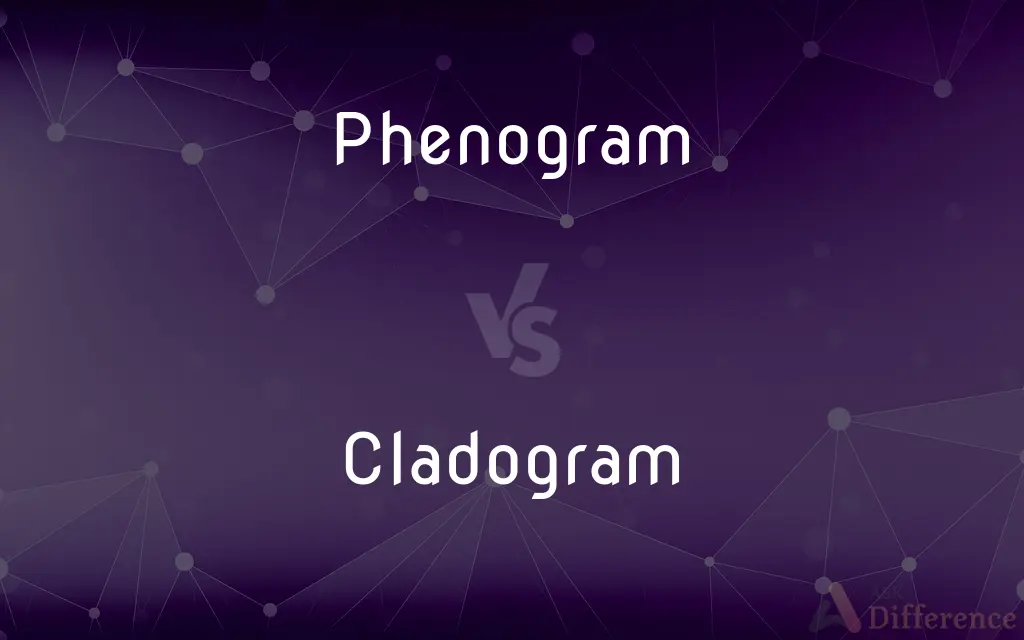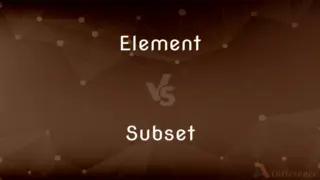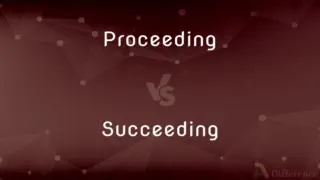Phenogram vs. Cladogram — What's the Difference?
By Fiza Rafique & Maham Liaqat — Updated on March 6, 2024
A phenogram depicts evolutionary relationships based on morphological or genetic similarities, while a cladogram shows relationships based on shared derived characteristics.

Difference Between Phenogram and Cladogram
Table of Contents
ADVERTISEMENT
Key Differences
Phenograms, also known as phenetic trees, are constructed based on the overall similarity between species, which can be morphological, biochemical, or genetic. They represent the degree of similarity using various statistical methods, without necessarily reflecting evolutionary pathways. Cladograms, in contrast, are based on the concept of shared derived characteristics, known as synapomorphies. These are traits that are present in an ancestral species and its descendants but absent in more distant relatives. Cladograms are used to hypothesize evolutionary relationships and show how closely species are related based on their evolutionary history, rather than just similarity.
While phenograms focus on similarity, which can result from convergent evolution (where unrelated species evolve similar traits), cladograms emphasize actual evolutionary relationships. This distinction is crucial because similarity does not always indicate common ancestry. For example, the wings of birds and insects are similar but evolved independently.
The construction of a cladogram involves identifying unique characteristics that define groups of organisms, then organizing these groups based on when these characteristics appeared in their lineage. This method helps clarify the evolutionary branching points, or nodes, which represent common ancestors.
Both phenograms and cladograms are tools in systematics, the study of the diversity of life and the relationships among living things. However, cladograms are considered more informative for understanding evolutionary relationships because they are based on the principle that characteristics appearing in recent common ancestors are more significant for classification than overall similarity.
Comparison Chart
Basis
Overall similarity (morphological, biochemical, genetic)
Shared derived characteristics (synapomorphies)
ADVERTISEMENT
Reflects
Degree of similarity, not necessarily evolutionary pathways
Hypothesized evolutionary relationships and history
Emphasis
Similarity, which can be due to convergent evolution
Actual evolutionary lineage and branching points
Method
Statistical analysis of similarity
Organizing species by shared derived traits
Use in Systematics
Shows how alike species are
Clarifies evolutionary relationships and classification
Compare with Definitions
Phenogram
Represents organisms based on overall similarity.
Phenograms use DNA sequences to group similar species.
Cladogram
Reflects hypothesized evolutionary history.
A cladogram illustrating the evolution of mammals from early synapsid ancestors.
Phenogram
A tree diagram showing similarity among species.
A phenogram illustrating the genetic similarity between different breeds of dogs.
Cladogram
Clarifies classification and evolutionary branching.
A cladogram revealing the relationship between dinosaurs and birds.
Phenogram
Based on statistical methods.
Cluster analysis used in creating a phenogram of plant species.
Cladogram
A diagram depicting evolutionary relationships.
A cladogram showing the relationships among vertebrate animals.
Phenogram
Does not necessarily indicate evolutionary pathways.
A phenogram might group sharks and dolphins closely due to similar body shapes.
Cladogram
Based on shared derived characteristics.
Cladograms use the presence of feathers to group birds separately from other reptiles.
Phenogram
Focuses on morphological, biochemical, or genetic data.
A phenogram comparing the biochemical traits of various fungi.
Cladogram
Organizes species by evolutionary lineage.
The cladogram demonstrates the divergent evolution of primates.
Phenogram
(genetics) A phenetic diagram (or cladogram)
Cladogram
A cladogram (from Greek clados "branch" and gramma "character") is a diagram used in cladistics to show relations among organisms. A cladogram is not, however, an evolutionary tree because it does not show how ancestors are related to descendants, nor does it show how much they have changed, so many differing evolutionary trees can be consistent with the same cladogram.
Cladogram
A branching, treelike diagram in which the endpoints of the branches represent individual species of organisms. It is used to illustrate phylogenetic relationships and to show points at which various species are presumed to have diverged from common ancestral forms.
Cladogram
(taxonomy) A branching treelike graphical representation of the phylogenetic relationships between organisms showing which taxa have branched from common ancestors.
Cladogram
(phylogenetics) A phylogenetic tree that is strictly the outcome of a cladistic analysis.
Cladogram
A tree diagram used to illustrate phylogenetic relationships
Common Curiosities
What are shared derived characteristics?
Shared derived characteristics, or synapomorphies, are traits that are present in an ancestral species and its descendants but absent in more distant relatives.
What is the main difference between a phenogram and a cladogram?
Phenograms are based on overall similarity, while cladograms are based on shared derived characteristics.
Can convergent evolution affect the construction of a phenogram?
Yes, convergent evolution can lead to unrelated species appearing similar on a phenogram, potentially misleading their relationship.
Can a phenogram show evolutionary relationships?
A phenogram can suggest relationships based on similarity, but it may not accurately reflect evolutionary history.
How do cladograms and phenograms contribute to taxonomy?
Both help in classifying organisms, but cladograms provide a more robust framework for understanding evolutionary relationships and taxonomy.
Why are cladograms considered more informative for understanding evolutionary relationships?
Cladograms are based on the principle of shared derived traits, offering a clearer picture of evolutionary pathways and common ancestry.
How do scientists decide which traits to use in constructing a cladogram?
Scientists choose traits that reflect evolutionary changes, focusing on those that indicate a divergence from a common ancestor.
Do cladograms show time or evolutionary distance?
Cladograms primarily show relationships and branching order; they do not directly indicate time or evolutionary distance without additional information.
Can a cladogram change with new evidence?
Yes, as new data and traits are discovered, the arrangement of a cladogram can be updated to better reflect evolutionary relationships.
Is a phenogram useful in any scenario?
Phenograms can be useful for quickly grouping organisms based on overall similarity for purposes like identification or preliminary analysis.
What is the significance of nodes in a cladogram?
Nodes represent common ancestors and are crucial for understanding the evolutionary divergence of lineages within a cladogram.
How does the principle of parsimony apply to cladograms?
Parsimony, choosing the simplest scientific explanation, guides the construction of cladograms to minimize the number of evolutionary changes assumed.
Can phenograms and cladograms be used together?
Yes, both can be used complementarily in systematic studies to provide a fuller picture of species relationships and similarities.
What role does DNA analysis play in constructing these diagrams?
DNA analysis is crucial for both, providing the data needed to assess similarity in phenograms and identify shared derived traits for cladograms.
How are phenograms and cladograms used in evolutionary biology?
They are tools for hypothesizing relationships among species, with cladograms being particularly valued for detailing evolutionary pathways.
Share Your Discovery

Previous Comparison
Element vs. Subset
Next Comparison
Proceeding vs. SucceedingAuthor Spotlight
Written by
Fiza RafiqueFiza Rafique is a skilled content writer at AskDifference.com, where she meticulously refines and enhances written pieces. Drawing from her vast editorial expertise, Fiza ensures clarity, accuracy, and precision in every article. Passionate about language, she continually seeks to elevate the quality of content for readers worldwide.
Co-written by
Maham Liaqat















































